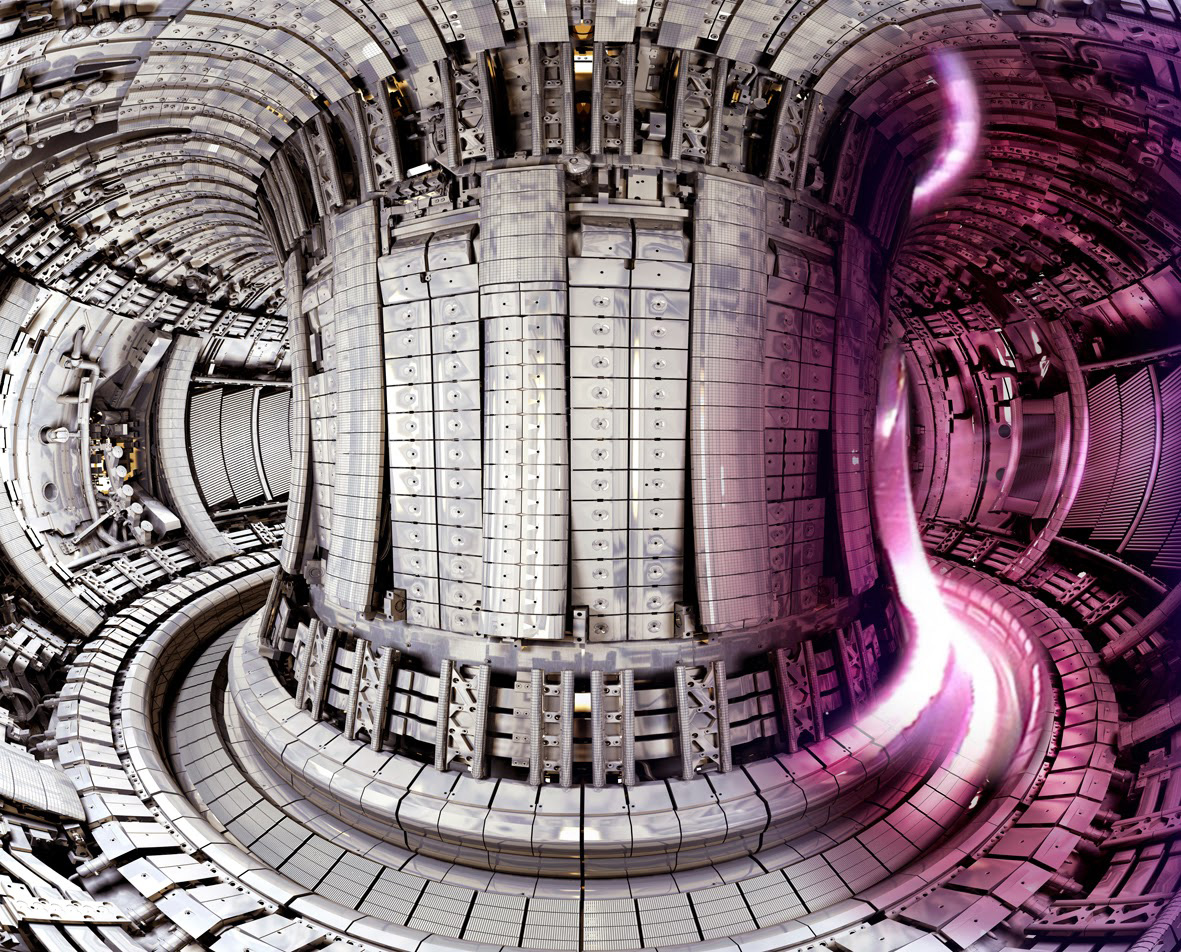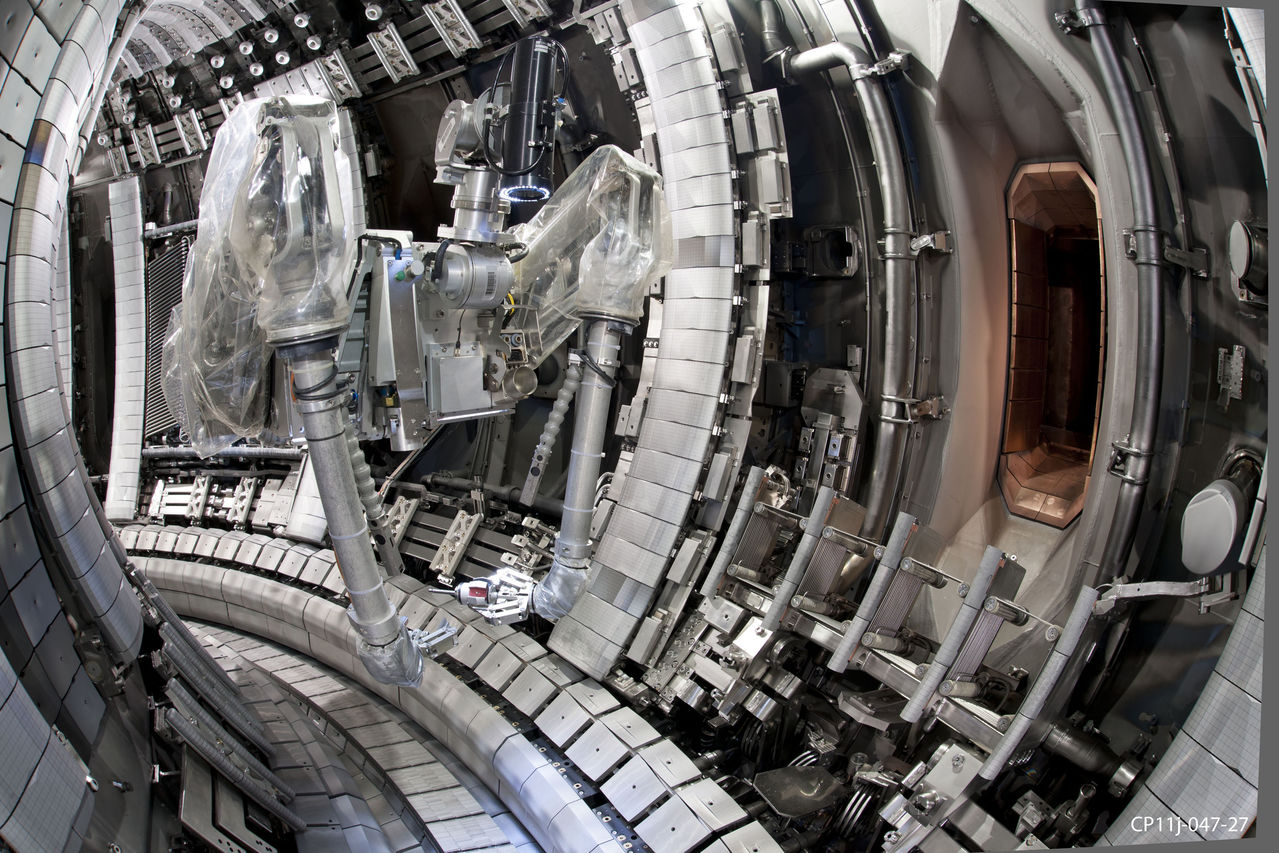Tokamak JET launches new deuterium-tritium campaign
After 18 months of preparation and repair, the world's largest tokamak, JET, is restoring work with the aim of launching next year with deuterium-tritium plasma, i.e. real thermonuclear launches. Similar experiments have not been conducted on tokamaks since the mid-90s, and it is time to test the accumulated new ideas experimentally.

Composite image of the JET tokamak vacuum chamber (about 8 meters in diameter) and plasma during experiments.
It was here, on JET in 1997, that the thermonuclear reaction power was set for magnetic traps - 16 megawatts for about 100 milliseconds. The duration then, however, was limited by the duration of the operation of the neutral injection system.responsible for the external heating of the plasma. Today, these restrictions are much softer, so there are plans to keep the 16-megawatt burning for ~ 5 seconds. Again, longer is impossible, because There is a certain limit on the total irradiation of the vacuum chamber design by thermonuclear neutrons.

Profiles of record-breaking thermonuclear experiments and a planned future.
An important change from 1997 was the conversion of the reactor to a full metal lining - carbon-fiber and graphite elements disappeared. The latter at one time helped to reduce the pollution of plasma with materials with high atomic numbers and pass the so-called “radiation barrier” on the way to thermonuclear temperatures. However, over time it became clear that in terms of operation, the metal wall is better - less dust, less tritium that is “stuck” in the construction. This is especially true of the divertor, an element to which plasma is “drained” to remove heat and pollution from the fusion region. ITER divertor

elementrecently made by Europe - lined with tungsten blocks and active cooling. The direct part has (at an acute angle) a plasma stream with a capacity of 5-10 megawatts / m ^ 2
In addition to the interaction of tritium with a perspective (planned and at ITER) full metal wall, solutions for suppressing ELM instabilities will also be tested using special guns firing frozen DT-mix pellets, well, a lot of tokmashnik ideas on plasma behavior.
In the course of the “experimental DT campaign No. 2 - DTE-2”, also, for the first time in history, plasma experiments on pure tritium are planned. Since the mass / charge ratio of tritium is one and a half times higher than that of deuterium, modeling and experiment can be compared on a variety of phenomena sensitive to this ratio.
According to the plans for the next few months, the machine will be commissioned, and then an approximately 5-month calibration series of physical experiments on deuterium. After about a 1-month test by the UK atomic surveillance of the readiness of all systems to work with tritium, a 3-month physical TT program will begin. This will be followed by additional safety drills, another acceptance, and finally, the four-month DTE-2 itself.
The very first launch of JET after a break on hydrogen plasma. Slow 40 times.
The long and complicated entry into this program of experiments is connected both with the nuisance of tritium itself and with induced radioactivity as a result of a thermonuclear reaction.
Tritium is volatile, like any hydrogen, flammable and highly radioactive gas. To work with it, it is necessary to install all equipment in sealed glove boxes, pipelines to be surrounded with hermetic second shells, to equip the building with a pressure reduction system (to reduce the likelihood of leakage to the outside) and oxygen content (to prevent fires that will be a nightmare in case of tritium). In total, the site can contain no more than 20 grams of tritium stored as uranium hydride (treytida?) And delivered to the heating system. But burned in all experiments will be only about 1 milligram. Such a big difference between the “warehouse” and needs is explained by the fact that when passing through the plasma a very small fraction of tritium burns, and the rest, unfortunately, is polluted with deuterium and antimony,

Calculated values of dose rate (radioactivity) inside the JET vacuum chamber as a result of thermonuclear activation. However, such activation quite quickly falls by 2-3 orders of magnitude.
The second most important engineering task here (and in the future - at ITER) will be work with an activated structure. At the end of DTE-2, the radiation background in the center of the vacuum chamber will reach 80 mSv / h (8 roentgens per hour), therefore, a remote-controlled robotics will be used for work inside . In the course of preparation, they already trained on replacing tiles, installing new ones, installing various sensors, etc.

Remote-controlled robot inside JET. It was used during the dismantling of the activated elements after DTE-1.
Finally, we need to mention another “fashionable” idea - liquid lithium walls, which solve many engineering problems in the durability of facing a chamber before the damaging effects of neutrons and plasma: for the first time, JET will test the interaction of such a wall and deuterium-tritium plasma.
In my opinion, such programs are, on the one hand, important for preparing the launch of a full-fledged deuterium-tritium campaign on ITER, and on the other hand, they emphasize the incredible difficulties in working with DT reaction. In conditions when thermonuclear power engineering is not a “saving straw” for civilization, it is difficult to expect bets on DT-reactors.

Composite image of the JET tokamak vacuum chamber (about 8 meters in diameter) and plasma during experiments.
It was here, on JET in 1997, that the thermonuclear reaction power was set for magnetic traps - 16 megawatts for about 100 milliseconds. The duration then, however, was limited by the duration of the operation of the neutral injection system.responsible for the external heating of the plasma. Today, these restrictions are much softer, so there are plans to keep the 16-megawatt burning for ~ 5 seconds. Again, longer is impossible, because There is a certain limit on the total irradiation of the vacuum chamber design by thermonuclear neutrons.

Profiles of record-breaking thermonuclear experiments and a planned future.
An important change from 1997 was the conversion of the reactor to a full metal lining - carbon-fiber and graphite elements disappeared. The latter at one time helped to reduce the pollution of plasma with materials with high atomic numbers and pass the so-called “radiation barrier” on the way to thermonuclear temperatures. However, over time it became clear that in terms of operation, the metal wall is better - less dust, less tritium that is “stuck” in the construction. This is especially true of the divertor, an element to which plasma is “drained” to remove heat and pollution from the fusion region. ITER divertor

elementrecently made by Europe - lined with tungsten blocks and active cooling. The direct part has (at an acute angle) a plasma stream with a capacity of 5-10 megawatts / m ^ 2
In addition to the interaction of tritium with a perspective (planned and at ITER) full metal wall, solutions for suppressing ELM instabilities will also be tested using special guns firing frozen DT-mix pellets, well, a lot of tokmashnik ideas on plasma behavior.
In the course of the “experimental DT campaign No. 2 - DTE-2”, also, for the first time in history, plasma experiments on pure tritium are planned. Since the mass / charge ratio of tritium is one and a half times higher than that of deuterium, modeling and experiment can be compared on a variety of phenomena sensitive to this ratio.
According to the plans for the next few months, the machine will be commissioned, and then an approximately 5-month calibration series of physical experiments on deuterium. After about a 1-month test by the UK atomic surveillance of the readiness of all systems to work with tritium, a 3-month physical TT program will begin. This will be followed by additional safety drills, another acceptance, and finally, the four-month DTE-2 itself.
The very first launch of JET after a break on hydrogen plasma. Slow 40 times.
The long and complicated entry into this program of experiments is connected both with the nuisance of tritium itself and with induced radioactivity as a result of a thermonuclear reaction.
Tritium is volatile, like any hydrogen, flammable and highly radioactive gas. To work with it, it is necessary to install all equipment in sealed glove boxes, pipelines to be surrounded with hermetic second shells, to equip the building with a pressure reduction system (to reduce the likelihood of leakage to the outside) and oxygen content (to prevent fires that will be a nightmare in case of tritium). In total, the site can contain no more than 20 grams of tritium stored as uranium hydride (treytida?) And delivered to the heating system. But burned in all experiments will be only about 1 milligram. Such a big difference between the “warehouse” and needs is explained by the fact that when passing through the plasma a very small fraction of tritium burns, and the rest, unfortunately, is polluted with deuterium and antimony,

Calculated values of dose rate (radioactivity) inside the JET vacuum chamber as a result of thermonuclear activation. However, such activation quite quickly falls by 2-3 orders of magnitude.
The second most important engineering task here (and in the future - at ITER) will be work with an activated structure. At the end of DTE-2, the radiation background in the center of the vacuum chamber will reach 80 mSv / h (8 roentgens per hour), therefore, a remote-controlled robotics will be used for work inside . In the course of preparation, they already trained on replacing tiles, installing new ones, installing various sensors, etc.

Remote-controlled robot inside JET. It was used during the dismantling of the activated elements after DTE-1.
Finally, we need to mention another “fashionable” idea - liquid lithium walls, which solve many engineering problems in the durability of facing a chamber before the damaging effects of neutrons and plasma: for the first time, JET will test the interaction of such a wall and deuterium-tritium plasma.
In my opinion, such programs are, on the one hand, important for preparing the launch of a full-fledged deuterium-tritium campaign on ITER, and on the other hand, they emphasize the incredible difficulties in working with DT reaction. In conditions when thermonuclear power engineering is not a “saving straw” for civilization, it is difficult to expect bets on DT-reactors.
